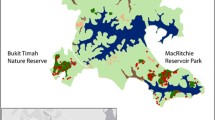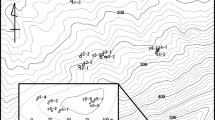Abstract
Habitat fragmentation often has negative consequences for genetic diversity, and thereby for the viability of populations. However, these negative consequences might be counteracted by gene flow as the latter provides functional connectivity between apparently isolated habitat fragments. Gene flow is itself influenced by landscape structure and composition, and it is therefore important to understand the relationship between gene flow and landscape structure and composition. We used linear LAD regression models to investigate the relationship between contemporary gene flow by pollen in the rare, insect-pollinated forest tree Sorbus domestica and several landscape features. None of the landscape components—which included closed forest, deep valleys, open land and settlements—proved to be an impermeable barrier to gene flow by pollen. We found evidence that settlements, large open areas, and a pronounced topography increased long-distance gene flow in the landscape as compared to a random model including all possible gene flow trajectories. These results are encouraging from a conservation view, as gene flow in species pollinated by generalist insects seems to provide functional connectivity and may help to maintain genetic diversity in rare plant species in fragmented landscapes.


Similar content being viewed by others
References
Austerlitz F, Dick CW, Dutech C, Klein EK, Oddou-Muratorio S, Smouse PE, Sork VL (2004) Using genetic markers to estimate the pollen dispersal curve. Mol Ecol 13:937–954
Bradshaw RHW, Hannon GE, Lister AM (2003) A long-term perspective on ungulate-vegetation interactions. For Ecol Manag 181:267–280
Brütsch U, Rotach P (1992) Der Speierling (Sorbus domestica) in der Schweiz: Verbreitung, Ökologie, Standortsansprüche, Konkurrenzkraft und waldbauliche Eignung. Schweiz Z Forstwes 144:967–991
Cade BS, Noon BR (2003) A gentle introduction to quantile regression for ecologists. Front Ecol Environ 1:412–420
Cade BS, Richards JD (1996) Permutation tests for least absolute deviation regression. Biometrics 52:886–902
Cade BS, Richards JD (2005) User Manual for BLOSSOM Statistical Software. U.S. Geological Survey, Fort Collins
Cushman SA, McKelvey KS, Hayden J, Schwartz MK (2006) Gene flow in complex landscapes: testing multiple hypotheses with causal modelling. Am Nat 168:486–499
Franke A, Dagenbach H (1995) Der Speierling ein seltener Baum in Wald und Flur. LG-Stiftung Natur und Umwelt, Stuttgart
Gram WK, Sork VL (2001) Association between environmental and genetic heterogeneity in forest tree populations. Ecology 82:2012–2021
Greenleaf SS, Williams NM, Winfree R, Kremen C (2007) Bee foraging ranges and their relationship to body size. Oecologia 153:589–596
Hamrick JL (2004) Response of forest trees to global environmental changes. For Ecol Manag 197:323–335
Holderegger R, Wagner HH (2008) Landscape genetics. Bioscience 58:199–207
Janzen DH (1971) Euglossine bees as long-distance pollinators of tropical plants. Science 171:203–205
Jenness J (2006) Surface Tools (surf_tools.avx) extension for ARCView 3.x, V1.6a. Jenness Enterprises. http://www.jennessent.com/arcview/surface_tools.htm
Kamm U, Rotach P, Gugerli F, Siroky M, Edwards PJ, Holderegger R (2009) Frequent long-distance gene flow in a rare temperate forest tree (Sorbus domestica) on the landscape scale. Heredity 103:476–482
Kreyer D, Oed A, Walther-Hellwig K, Frankl R (2004) Are forests potential landscape barriers for foraging bumblebees? Landscape scale experiments with Bombus terrestris agg. and Bombus pascuorum (Hymenoptera, Apidae). Biol Conserv 116:111–118
Kutzelnigg H (1995) Sorbus. In: Scholz H (ed) Gustav Hegi – Illustrierte Flora von Mitteleuropa, 2nd edn. Blackwell, Berlin, pp 328–385
Kwak MM, Velterop O, van Andel J (1998) Pollen and gene flow in fragmented habitats. Appl Veg Sci 1:37–54
Legendre P, Legendre L (1998) Numerical ecology. Elsevier Science, Amsterdam. Program available at: www.bio.umontreal.ca/Casgrain/en/labo/corr_permute.html
Lowe AJ, Boshier D, Ward M, Bacles CFE, Navarro C (2005) Genetic resource impacts of habitat loss and degradation; reconciling empirical evidence and predicted theory for neotropical trees. Heredity 95:255–273
Manel S, Schwartz MK, Luikart G, Taberlet P (2003) Landscape genetics: combining landscape ecology and population genetics. Trends Ecol Evol 18:189–197
Marshall TC, Slate J, Kruuk LEB, Pemberton JM (1998) Statistical confidence for likelihood-based paternity inference in natural populations. Mol Ecol 7:639–655
McRae BH (2006) Isolation by resistance. Evolution 60:1551–1561
Meagher T (1986) Analysis of paternity within a natural population of Chamaelirium luteum. 1. Identification of most-likely male parents. Am Nat 128:199–215
Nason JD, Herre EA, Hamrick JL (1998) The breeding structure of a tropical keystone plant resource. Nature 391:685–687
Oddou-Muratorio S, Klein EK, Demesure-Musch B, Austerlitz F (2006) Real-time patterns of pollen flow in the wild-service tree, Sorbus torminalis (Rosaceae). III. Mating patterns and the ecological maternal neighborhood. Am J Bot 93:1650–1659
Raspé O, Findlay C, Jacquemart A-L (2000) Biological flora of the British Isles: Sorbus aucuparia L. J Ecology 88:910–930
Schrott GR, With KA, King AW (2005) On the importance of landscape history for assessing extinction risk. Ecol Appl 15:493–506
Sork VL, Nason J, Campbell DR, Fernandez JF (1999) Landscape approaches to historical and contemporary gene flow in plants. Trends Ecol Evol 14:219–224
Steffan-Dewenter I, Kuhn A (2003) Honeybee foraging in differentially structured landscapes. Proc R Soc Lond B 270:569–575
Steffan-Dewenter I, Munzenberg U, Burger C, Thies C, Tscharntke T (2002) Scale-dependent effects of landscape context on three pollinator guilds. Ecology 83:1421–1432
Storfer A, Murphy MA, Evans JS, Goldberg CS, Robinson S, Spear SF, Dezzani R, Delmelle E, Vierling L, Waits LP (2007) Putting the ‘landscape’ in landscape genetics. Heredity 98:128–142
Townsend PA, Levey DJ (2005) An experimental test of whether habitat corridors affect pollen transfer. Ecology 86:466–475
White GM, Boshier DH, Powell W (2002) Increased pollen flow counteracts fragmentation in a tropical dry forest: an example from Swietenia humilis (Zuccarini). PNAS 99:2038–2042
Whitlock MC, McCauley DE (1999) Indirect measures of gene flow and migration: Fst ≠ 1/(4Nm + 1). Heredity 82:117–125
Winfree R, Griswold T, Kremen C (2007) Effect of human disturbance on bee communities in a forested ecosystem. Conserv Biol 21:213–223
Winston ML (1987) The biology of the honey bee. Harvard University Press, Boston
Young A, Boyle T, Brown T (1996) The population genetic consequences of habitat fragmentation for plants. Trends Ecol Evol 11:413–418
Acknowledgements
This work would not have been possible without decades of fieldwork of many students and foresters in the Canton of Schaffhausen under the supervision of Peter Rotach. This study was supported by research grants from the Swiss Federal Institute of Technology Zurich (TH -33/04-2). Two anonymous reviewers gave very valuable comments that helped us to improve the manuscript.
Author information
Authors and Affiliations
Corresponding author
Rights and permissions
About this article
Cite this article
Kamm, U., Gugerli, F., Rotach, P. et al. Open areas in a landscape enhance pollen-mediated gene flow of a tree species: evidence from northern Switzerland. Landscape Ecol 25, 903–911 (2010). https://doi.org/10.1007/s10980-010-9468-z
Received:
Accepted:
Published:
Issue Date:
DOI: https://doi.org/10.1007/s10980-010-9468-z




